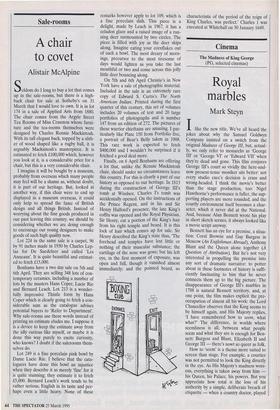Cinema
The Madness of King George (PG, selected cinemas)
Royal marbles
Mark Steyn
Ilike the new title. We've all heard the jokes about why the Samuel Goldwyn Company insisted on a switch from the original Madness of George III, but, actual- ly, we only refer to monarchs as 'George III' or 'George VI' or 'Edward VII' when they're dead and gone. This film conjures George III's court so vividly the here-and- now present-tense moniker sits better: not every studio exec's decision is crass and wrong-headed. I think the movie's better than the stage production, too: Nigel Hawthome's performance is fuller, the sup- porting players are more rounded, and the courtly environment itself becomes a char- acter, which it never did at the National. And, because Alan Bennett wrote his play in short sketch scenes, it always looked like a movie script anyway. Bennett has an eye for a premise, a situa- tion: Coral Browne and Guy Burgess in Moscow (An Englishman Abroad), Anthony Blunt and the Queen alone together (A Question of Attribution). But he's not very interested in propelling the premise into any sort of dramatic narrative: to potter about in these footnotes of history is suffi- ciently fascinating to him that he never connects them up to the big picture. The disappearance of George III's marbles in 1788 is natural Bennett territory, and, at one point, the film makes explicit the pre- occupation of almost all his work: the Lord Chancellor observes that the King seems to be himself again, and His Majesty replies, `I have remembered how to seem, what what?' The difference, in worlds where seemliness is all, between what people seem and what they are is enough for Ben- nett: Burgess and Blunt, Elizabeth II and George III — there's nowt so queer as folk. How to `seem' is a theme more suited to screen than stage. For example, a courtier was not permitted to look the King directly in the eye. As His Majesty's madness wors- ens, everything is taken away from him his Queen, his Palace, his powers. But you appreciate how total is the loss of his authority by a simple, deliberate breach of etiquette — when a country doctor, played by Ian Holm, fixes His Majesty in his eye. This is a film moment. Indeed, between the King and the doctor and the inscrutable Pitt, much of the picture is taken up with heavyweight eye-acting. Hawthorne is espe- cially strong: in the early scenes, he's a merry monarch with dancing eyes; by the time Holm has strapped him. into strait- jackets and restraining chairs, the eyes have dimmed and dulled, and yet deep within flickers a faint awareness of his own degradation.
Hawthorne's performance starts as a turn — thundering and boisterous, what-what- mg and hey-hey-ing — and that's the way the posters sells the picture: 'All knowing. All powerful. But is he all there?' That's the easy way to dramatise madness — through the eyes of everyone else who has to put up with it: 'If a few ramshackle colonists in America can send him packing, why can't we?'. But, as the King's irrationality increas- es, the film shifts its point of view: Hawthorne's performance is immensely moving; he draws you in and holds your sympathies. That's not easy: when a man loses his reason, there's less reason to be interested in him. But maybe monarchs are an exception: 'The state of monarchy and the state of lunacy share a frontier,' says one physician. The trappings and protocol are so lacking in reason anyway that it's the mad- ness that makes him human; he becomes engaging not ex officio but personally.
The play's director, Nicholas Hytner, making his film debut, serves Hawthorne well. The script benefits from both the close-ups and crowd scenes denied it on stage. A king spends much of his life in crowds and it's vaguely unsatisfying not to be able to see the full retinue. Equally, it's a huge advantage to be taken into the Royal bedroom and perched like Michael Pagin at the end of the four-poster while Hawthorne and Helen Mirren address each other as Mr and Mrs King: these scenes are intimate and touching. Hytner has also unobtrusively choreographed the film. When the King is in control, the shots are framed like still photographs — Their Majesties seated, with family and courtiers arranged behind; when suddenly the King lashes out, the camera also careers around, scrambling like the train of frantic flunkeys to catch up. As the madness accelerates, the plush, Royal blues and reds and golds seem to be drained from the screen: he winds up in a room without furniture, strapped down not by bewigged and buck- led servants but by thugs dressed in black. It turns out to be porphyria — which, as the closing caption notes, is hereditary. That and a scene in which the King urges his off- spring to be 'a model family' for the nation are cheap shots, hinting at contemporary parallels the film itself can't be bothered to draw. But that's Bennett's fault. Hawthorne and Hytner have taken a slight riff on a Royal anecdote and turned it into a rich fugue. So why does Bennett get an Oscar nomination and not Hytner?



























































 Previous page
Previous page